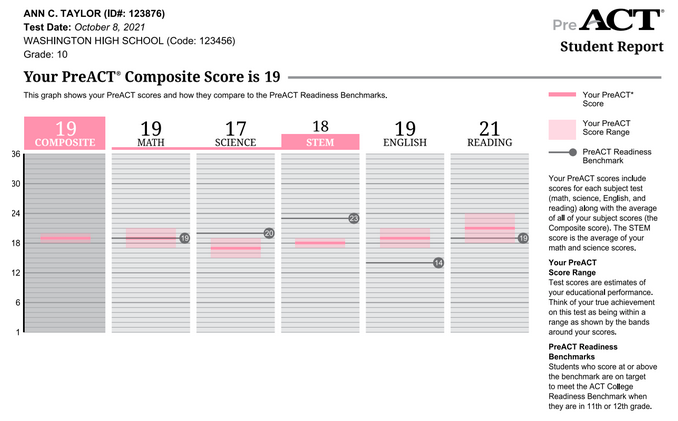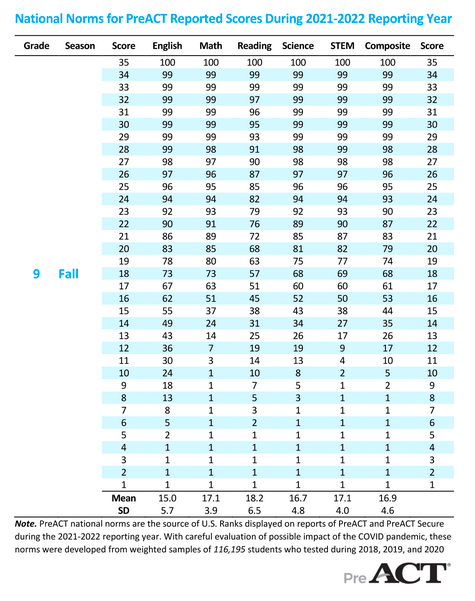What is a Good PreACT Score? How to Understand Your Score
What’s Covered:
- How is the PreACT Scored?
- What is a Good PreACT Score?
- Do PreACT Scores Predict ACT Scores?
- How to Get your PreACT Scores
- ACT Resources
If you’re here, you’re either about to take the PreACT, or you have recently taken it, and are a little confused by the scoring system. If you haven’t taken it yet, make sure you brush up on the test itself. While it is just a pre-test, it gives you a valuable chance to experience and practice for the actual ACT, and hone your study skills based on your PreACT scores. The test takes about two hours, and includes questions on English/Language Arts, Math, Reading, and Science. It does not include a writing section, although you can opt into a writing section on the main ACT test. Once you’ve taken the test, you’ll get a score sheet back with several main areas. Here, we’ll break down PreACT scores, how they can impact your college admissions, and, of course, how to find your PreACT scores!
How is the PreACT Scored?
PreACT scores include a lot of information. It starts with your composite score.
Your PreACT score will range from 1-35, while ACT scores range from 1-36. Both tests take the number of questions you answered correctly and translate that into your score, though the conversion will vary based on the curve. Your composite score is the average of the English, Math, Reading, and Science test scores, all rounded to a whole number. The STEM score is the average of your Math and Science scores.
The next section contains your predicted ACT score ranges. This is an estimate, and you can increase your score chances through preparation, studying, and practice. That will look like this:
Then, you will see your Progress Toward the ACT National Career Readiness Certificate. It is an estimate of the ACT National Career Readiness Certificate that students with your PreACT scores are likely to earn in their junior year. It documents foundational work skills that are important for job success across industries and companies. It will also show your percentile ranks. The percentile ranks are the percentage of students who earned a score equal to or lower than your score. So, this student scored as high or higher than 68% of students. It will look like this:
You will also find a list of topics that were covered on each test. Beside each is the number of questions you answered correctly and the total number of questions related to that topic. The bar graphs show your topics with the highest and lowest percentages of correct answers. It looks like this:
What is a Good, Average, and Below Average PreACT Score
“Good” and “bad” scores, first off, depend on the student. If you don’t get the PreACT scores you wanted, that’s okay! Remember, a lot of scores are tied to when the test is taken. 79% of ninth-graders who took the test in the fall scored a 20 or below. That number drops to 75% in the spring of ninth-grade, 70% in the fall of tenth-grade, and 65% in the spring of tenth-grade. That shows that what is considered “average” can vary a lot! Because you’ll be more prepared later in high school, the average PreACT is higher for students in 10th compared to 9th grade.
Since the PreACT is scored very similar to the ACT, if you really want an average, you can use the average ACT score, which is about 20.8.
Though your score breakdown will show you where you rank compared to the rest of the country, you can use the tables below to see the general breakdown of the U.S. All of this information comes from the ACT Knowledge Hub on the ACT website.
National Norms Table
The numbers in the table below are national norms. They show the cumulative percentage for students who scored at or below a given score. You’ll find one of the subject area test scores, STEM, or composite score in the far-left column, then read across to the column for that subject area to locate the national rank for that score.
For example, the national rank for a composite score of 19 when taken by ninth-graders in the fall is 74. That means 74% of them received a score of 19 or below.

How does the PreACT Affect Your College Admissions?
Short answer: It doesn’t.
Long answer: It doesn’t, but it can help you study for the ACT, which can be a big part of admissions, particularly if you’re applying to a more sective school that uses the Academic Index (AI). This is a single number that represents the strength of your GPA and test scores. If your AI falls below a certain threshold, some schools may not consider your application.
The PreACT shows how likely you are to be ready for college-level work if your academics continue at the pace they are on. Start with the first graph, showing your composite and individual scores. Compare your score to the PreACT Readiness Benchmarks (the gray lines). If you’re scoring at or near those lines, you’re likely on track to do well with college-level courses in the future. If you are scoring well below those lines, you know you will need to work a little harder to get where you want to be. Even if you are scoring at or above those lines, that assumes you will continue to work as hard or harder than you currently are.
If you’re nervous about getting into school, try putting your information in our free Chancing Engine. You can factor in your standardized test scores, grades, extracurriculars, background, intended major, and more, to see your chances at hundreds of schools.
Do PreACT Scores Predict ACT Scores?
The PreACT predicts your ACT scores based on the scores you earn. This works because the PreACT and the ACT cover the same subject areas. The PreACT is usually taken in tenth-grade, while the ACT is usually taken in eleventh-grade. Both measure college-readiness. However, there is a lot you can do to change your scores, both positively and negatively. If you continue on the same academic pace, work hard, and study, you can continue or improve upon the score you earned on the PreACT. If you get a little lazy, it is possible that your ACT score could be lower than your PreACT. You don’t want that! While the PreACT doesn’t affect college admissions, the ACT does.
How to Use PreACT Scores to Prepare for the ACT
Based on your score ranges, particularly in the detailed results, you can see where you may need to improve. The categories with the highest percentages are categories you can feel confident in. In the example above, this student is very comfortable with Number and Quantity, Functions, Production of Writing, Knowledge of Language, and Key Ideas & Details. However, they should probably work on Geometry, Statistics & Probability, Modeling, and Interpretation of Data. From there, you can take practice tests online covering those specific subjects! We list resources in the next section to help you study.
How to Get Your PreACT Scores
Your PreACT scores will come as Individual Student Reports (ISR) within one to two weeks of the test. Your school should receive your ISR and distribute it to you.
ACT Resources
Luckily, we’ve got a ton of resources to help you prepare for the ACT. Here are some great study materials:
- Understanding the ACT
- ACT Section Guides
- English
- Math
- Reading
- Science
- Writing
- Prepping for the ACT
- Understanding Your Score







